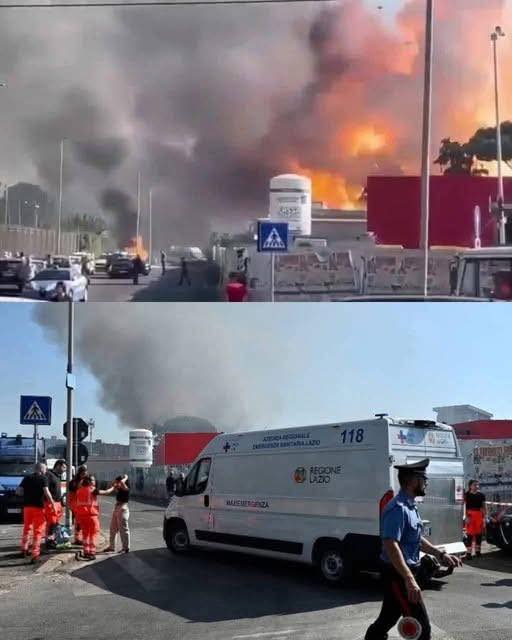Mexico City is reeling from one of its most devastating road disasters in recent memory after a liquefied petroleum gas (LPG) tanker overturned and exploded on the Iztapalapa–Chalco highway, unleashing a fireball that consumed vehicles, destroyed property, and left dozens of people dead or injured.
The explosion, which occurred on September 10, 2025, turned an ordinary afternoon commute into a scene of panic and chaos. Eyewitnesses reported a thunderous blast, a wave of heat, and a rising column of black smoke that was visible from miles away. Within minutes, the tragedy went viral online, with videos of the firestorm spreading across social media and igniting widespread outrage and grief.
What Happened
Authorities confirmed that the tanker was carrying more than 13,000 gallons of LPG, an extremely flammable fuel used in homes and businesses throughout Mexico. While traveling the busy corridor on the eastern edge of the capital, the driver reportedly lost control. The vehicle overturned, rupturing its tank, and within moments, the leaked gas ignited.
Witnesses described a terrifying scene as flames engulfed nearby cars and motorcycles, leaving commuters scrambling for safety. Some people abandoned their vehicles on the spot and ran down the highway to escape the inferno. Others who were caught in traffic had no choice but to watch in horror as the tanker erupted.
Firefighters and emergency crews rushed to the site and battled the blaze for hours. Their priority was both to contain the fire and to prevent secondary explosions, as additional vehicles burned in the pileup. Roads in the area were shut down immediately, causing widespread traffic disruption but giving rescuers space to evacuate survivors.
Casualties and Damage
The human toll has been devastating. Early reports listed three fatalities, but updated counts indicate that at least 15 people have died and more than 70 others were injured, many of them suffering severe burns. Hospitals across the city reported an influx of patients, some in critical condition, requiring urgent surgery and specialized burn care.
Beyond the immediate loss of life, the property damage was severe. More than 30 vehicles were either destroyed or heavily damaged. The intense heat left twisted metal carcasses of cars strewn across the highway. Homes and businesses near the site also reported shattered windows and structural damage caused by the shockwave of the explosion.
Investigation Underway
City officials have opened a full investigation into the crash. Authorities are looking at multiple possible causes, including mechanical failure, excessive speed, or driver error. Early findings suggest the tanker may not have had the proper insurance or safety documentation to transport hazardous cargo.
“This was not only a tragic accident but potentially a preventable one,” a Mexico City transportation official told reporters. “If we find negligence or regulatory violations, those responsible will be held accountable.”
Community in Shock
The blast has shaken the community far beyond the immediate neighborhood. Residents living near the highway reported that their homes shook as if from an earthquake, while others feared secondary explosions and evacuated their homes in panic.
Many are now demanding stricter regulations on the transport of hazardous materials through Mexico’s densely populated capital. “We live right next to this highway,” one resident told local media. “Every day these trucks pass by. It could happen again tomorrow. We can’t live with this kind of danger hanging over us.”
City officials are already discussing rerouting policies to prevent tankers carrying dangerous cargo from passing so close to residential areas. Others are calling for mandatory inspections and better driver training to reduce risks.
Safety Lessons and Next Steps
This tragedy underscores the urgent need for stronger safety measures. Experts point to several key areas where reforms are badly needed:
- Stricter vehicle inspections to ensure that tankers carrying hazardous materials are mechanically sound and equipped with the latest safety technology.
- Enhanced driver training, including how to respond to emergencies such as rollovers or fuel leaks.
- Clearer routing policies to keep tankers away from heavily populated zones whenever possible.
- Rapid emergency response planning, ensuring that cities are prepared to deal with similar disasters quickly and effectively.
Transportation analysts note that Mexico has seen multiple accidents involving fuel and gas transport in recent years, often linked to poor enforcement of safety standards. The Iztapalapa explosion, they argue, should serve as a wake-up call for both the government and private companies responsible for moving dangerous cargo.
A Nation Mourns
For the families of the victims, these reforms will come too late. Dozens of households are now grieving lost loved ones or waiting anxiously at hospital bedsides. Community groups have already begun collecting donations of blood, medical supplies, and funds to support the injured and their families.
At the national level, officials have promised accountability, but anger is growing among citizens who feel such promises are rarely kept. “Every time, they say the same thing—that changes will come,” one witness remarked. “But people keep dying, and nothing changes.”
Conclusion
The Mexico City gas tanker explosion is more than just another highway accident. It is a sobering reminder of the risks that accompany the transport of hazardous materials, especially in a city as crowded and vulnerable as the capital. While the investigation continues, the scars—both physical and emotional—will remain.
The road may eventually reopen, the smoke may fade, but the memory of September 10, 2025, will stay with Mexico City for years to come.

